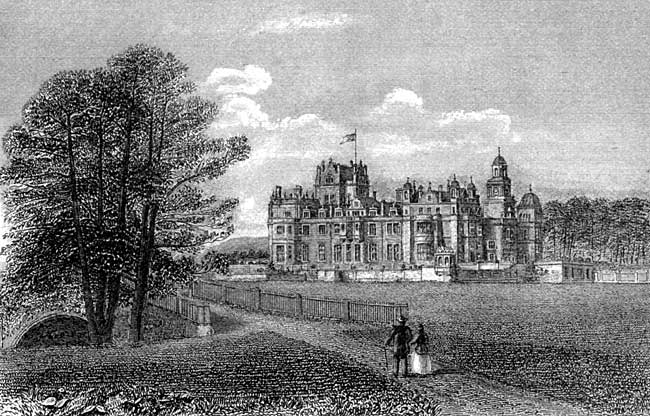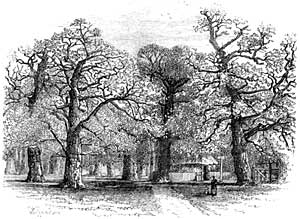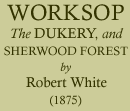< Previous | Contents | Next >

Thoresby

THORESBY.
WE now accompany the visitor to THORESBY, the seat of the Earl Manvers. Taking the road on the right of Clumber House, we cross the lake by a beautiful bridge of three arches. From this bridge we have the finest view that can be obtained in the park. Looking towards the mansion immediately before us, the waters of the lake flowing amongst miniature islands and rocks form numerous mimic cascades. The sound of the falling waters, mingled with the cry of alarm from the water-fowl as they rapidly rise from their quiet and secluded retreat beneath the pendant foliage, toying and sporting with every breath of air, and the trees dipping their leaves and branches in the water, all combine to relieve the exceeding quiet and stillness of the scene. To the left is the mansion, skirted by the gloomy cedars, and beyond, the lake expanding into a noble sheet of water is embosomed in magnificent woods, extending far as the eye can reach.
After pursuing the road for about two miles, the magnificent park of Thoresby opens upon our view. Well might Pemberton, "the Wanderer," who was a true lover of nature, say that this spot was to him the most "exciting example of park scenery in the kingdom."

Buck Gates.
The park includes an area of about thirteen miles in circumference, and it contains an unusually large quantity of deer. The lake is so arranged as to represent an extensive river, and being amphitheatrically surrounded with lawns in varied and verdant slopes, has a fine effect.
A former mansion at Thoresby, the Seat of the Duke of Kingston, was destroyed by fire April 4th, 1745, when nothing was saved "but the writings, plate, and some little of the best furniture" and the mansion built shortly afterwards by the last Duke of Kingston has just been taken down to give place to the present noble structure.
Thoresby is not without interesting historical associations; here was born the Lady Mary Pierrepont, who in 1712 married Mr. Edward Wortley Montague, and consequently became Lady Mary Wortley Montague.
At the age of twelve years she wrote in verse, and at nineteen translated the Enchiridion of Epictetus. She acquired a knowledge of the Greek, Latin, and French languages, and Bishop Burnet became her tutor. She was afterwards well known by her "Letters" descriptive of Turkish Harems, and as the one who introduced into this country from Turkey the practice of inoculation, in defiance of an amount of opposition from clergy and laity seldom equalled. Of the former Lord Wharncliffe, in his "Life and Letters" of this extraordinary woman, says "they descanted from their pulpits on the impropriety of thus seeking to take events out of the hand of Providence."
Thoresby must be named as the hospitable retreat of the celebrated Corsican patriot, Pascal Paoli, who, having fought against the Genoese and then the French, after a long and unequal contest was compelled to leave his once free and independent country in possession of Louis xv. and seek refuge with his friend the Duke of Kingston.
The present noble owner is descended from Robert de Perpont, whose name is derived from the castle of Pierrepont in Picardy in France, and who came into England with the Norman conqueror. Robert, as appears by Domesday Book, settled in the south of England, and held large possessions in Sussex, at Hurst Pierpoint, and other places, amounting to ten knights’ fees, under the famous William de Warren and also in Suffolk, where he held the lordships of Henestede and Wretham. About the middle of the thirteenth century his descendant in the fifth degree, Henry de Pierrepont, married Annora de Manvers, daughter of Michael de Manvers, and Sister and heiress of Lionel de Manvers, who brought Holm Pierrepont and other possessions in Nottinghamshire and elsewhere into the family. Sir Robert de Pierrepont, son of Henry, was in 1306, 34 Edward I., with Edward, Prince of Wales, in the notable expedition into Scotland, when Sir Robert Bruce was defeated at Methven; also in 3 Edward II. again in those wars. In 1315, 8 Edward II., he had summons to be at Newcastle with arms and horses to restrain the hostilities of the Scots. In 9 Edward II. he obtained a charter of Free-warren in all his demesnelands in Holm, Holbeck-Woodhouse, Landford, and Weston in Nottinghamshire; also those in North and South Anston and Treeton, in the county of York. In 2d Edward II. he was made governor of Newark Castle, and in 1327, 1st Edward III., he was summoned to the Scotch war, and was one of the chief commanders there in the army, led by the young king in person. In consideration of the special services rendered by him in Scotland, he obtained a general pardon for all trespasses by him done in the Forest of Sherwood, as well in vert as venison, having been with the king in 1333 in the great battle of Hallidown. Edward II., by letter from Woodstock 27th June, 1316, wrote to "Robert de Perpont and others to raise two thousand footmen in the counties of Nottingham and Derby, to be led to Newcastle-on-Tine for the wars in Scotland." In 1470 Henry Pierrepont became famous for his faithful services against the Lancastrians, and had granted to him the third part of the manor of Staley (Staveley). Leaving no issue, Francis, his brother, succeeded to the inheritance, who left a son, Sir William Pierrepont, who was made a Knight Banneret 1513 for his exemplary valour at the sieges of Therouenne and Tournay and "the battle of Spurs." He was succeeded by George, his son, who received the honour of knighthood in 1546 from Edward VI., and died in the sixth of Elizabeth. Henry, his son and heir, married Frances, daughter of Sir William Cavendish and the celebrated "Bess of Hardwick," Countess of Shrewsbury, and dying in 1615, aged 69, left issue, Robert, who in 1627 was created Baron Pierrepont of Hom-Pierrepont, and Viscount Newark, and in 1628 advanced to the dignity of Earl of Kingston. He took an active part in the Parliamentary wars, on behalf of the king, and was accidentally killed before Gainsborough by those of his own party, while they were in pursuit of a vessel in which he was being carried captive to Hull July 30, 1643. He was called "the good Earl of Kingston"; and having married Gertrude, daughter and co-heiress of Henry Talbot, fourth son to George, sixth Earl of Shrewsbury, was succeeded by his eldest son Henry, who was created Marquis of Dorchester in 1643. At his death, in i68o, this title became extinct, but the earldom devolved on Robert, third earl, grandson and heir of William Pierrepont, Esq., of Thoresby, the Marquis’s next brother, who married a daughter and co-heiress of Sir Thomas Harris, of Tong Castle, county Salop. Robert, third earl, died in 1682, and was successively followed by his two brothers William and Evelyn. This Evelyn, the fifth earl, was created Marquis of Dorchester in 1706, and Duke of Kingston-upon-Hull in 1715. He married, first, Lady Mary Fielding, daughter of William, third Earl of Denbigh, and secondly, Lady Isabella Bentinck, daughter of William, first Earl of Portland. By his first marriage he had three daughters, the eldest of whom was the celebrated Lady Mary Wortley Montague, and one son, William, Earl of Kingston, who died in 1713, while his father was Marquis of Dorchester, leaving a son, Evelyn, afterwards second duke and K.G., who succeeded his grandfather in 1726, and on whose death in 1773 the titles became extinct.
